San Rafael, December 2013
Thank you for your help!
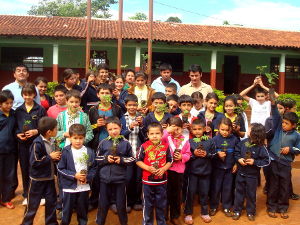 Without your donations we wouldn't have been able to carry out many of the important measures dedicated to the preservation of San Rafael! Thank you very much! Your support is greatly appreciated. Our most important areas of work remain environmental education, the work with smallholders, reforestation measures, the cooperation with scientific institutions, and the monitoring of the protected area.
Without your donations we wouldn't have been able to carry out many of the important measures dedicated to the preservation of San Rafael! Thank you very much! Your support is greatly appreciated. Our most important areas of work remain environmental education, the work with smallholders, reforestation measures, the cooperation with scientific institutions, and the monitoring of the protected area.
Environmental training
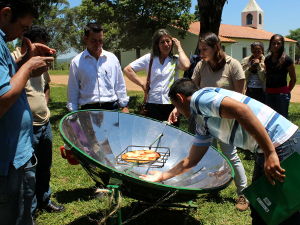 Each year we select one topic which will form the basis of our environmental education programmes - one which is then worked on together with the pupils. The teachers too are given specific training on this topic and its related themes. This year our principal theme was climate change. The explanation of the global connections, as well as the effects of greenhouse gases on the earth's atmosphere were an important part of our training. We focused particularly on the power of each individual to make a contribution towards protecting the climate. For example, we showed the people how to use a solar cooker and were thus able to demonstrate how to cook without using wood or fossil fuels. We also produced clear, easy-to-follow brochures which were then made available to each pupil. The planting in school yards was also continued. This year in one school in Carumbey the Lapacho trees which were planted by the children 3 years ago blossomed for the first time!
Each year we select one topic which will form the basis of our environmental education programmes - one which is then worked on together with the pupils. The teachers too are given specific training on this topic and its related themes. This year our principal theme was climate change. The explanation of the global connections, as well as the effects of greenhouse gases on the earth's atmosphere were an important part of our training. We focused particularly on the power of each individual to make a contribution towards protecting the climate. For example, we showed the people how to use a solar cooker and were thus able to demonstrate how to cook without using wood or fossil fuels. We also produced clear, easy-to-follow brochures which were then made available to each pupil. The planting in school yards was also continued. This year in one school in Carumbey the Lapacho trees which were planted by the children 3 years ago blossomed for the first time!
Work with smallholders
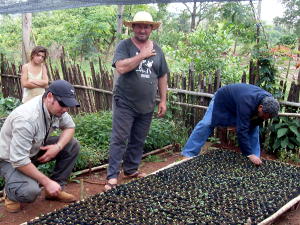 Our work with the smallholders in the surrounding area continues. The farmers receive educational support from the faculty for agriculture and forestry which supports them in matters relating to environmental protection and crop growth. Forestation measures are undertaken along the course of water ways and cultivation is diversified. Various seeds and seedlings were made available to the farmers with the aim of providing them with enough food and firewood to make them self-sufficient and also provide them with a steady means of income. In this way it is possible to achieve long-term improvements in the living standards of the farmers, while at the same time reducing the pressure on the forest. Only by means of the successful integration of the locals will it be possible to achieve our goal of saving the forest. This work is being supported by the UNDP (United Nations Development Programme)
Our work with the smallholders in the surrounding area continues. The farmers receive educational support from the faculty for agriculture and forestry which supports them in matters relating to environmental protection and crop growth. Forestation measures are undertaken along the course of water ways and cultivation is diversified. Various seeds and seedlings were made available to the farmers with the aim of providing them with enough food and firewood to make them self-sufficient and also provide them with a steady means of income. In this way it is possible to achieve long-term improvements in the living standards of the farmers, while at the same time reducing the pressure on the forest. Only by means of the successful integration of the locals will it be possible to achieve our goal of saving the forest. This work is being supported by the UNDP (United Nations Development Programme)
Tree nurseries and tree planting measures
 In the village of Trinidad, which is renowned for its Jesuit ruins, trees native to the area were planted on the village square, along a street and also in the area of the Jesuit ruins itself. Furthermore, a large information sign was erected informing the people about the protected area of San Rafael. The tree saplings were purchased from the tree nurseries run by smallholders and which were set up by ourselves as a way of supporting the farmers. In the parish of Obligado trees from the Atlantic Forest were planted along the course of a stream. In future this area will serve as a recreational area for locals and should also act as a model for other projects. Furthermore, the trees were signposted so as to inform the locals about the different species of trees.
In the village of Trinidad, which is renowned for its Jesuit ruins, trees native to the area were planted on the village square, along a street and also in the area of the Jesuit ruins itself. Furthermore, a large information sign was erected informing the people about the protected area of San Rafael. The tree saplings were purchased from the tree nurseries run by smallholders and which were set up by ourselves as a way of supporting the farmers. In the parish of Obligado trees from the Atlantic Forest were planted along the course of a stream. In future this area will serve as a recreational area for locals and should also act as a model for other projects. Furthermore, the trees were signposted so as to inform the locals about the different species of trees.
Scientific studies
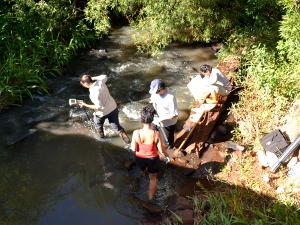 This year saw, once again, the completion and continuation of several scientific studies in San Rafael. With the support of the University of Salamanca (Spain), various Master's thesis were completed. One of these dissertations consisted of the analysis and evaluation of satellite pictures of the nature reserve taken between the years 2006 and 2012. The aim of the evaluation was to assess the extent of the loss of forest surface area due to clearing activities and forest fires. The study revealed that approximately 3,000 hectares of forest in the protected area (itself 73,000 hectares large) had been lost as a result of illegal forest clearing activities.
Additionally, scientists from Argentina monitored water courses in and around the nature reserve in order to assess the influence on the water of agrochemicals related to the mass-cultivation of soya. This long-term study is still continuing and we await the results with baited breath.
This year saw, once again, the completion and continuation of several scientific studies in San Rafael. With the support of the University of Salamanca (Spain), various Master's thesis were completed. One of these dissertations consisted of the analysis and evaluation of satellite pictures of the nature reserve taken between the years 2006 and 2012. The aim of the evaluation was to assess the extent of the loss of forest surface area due to clearing activities and forest fires. The study revealed that approximately 3,000 hectares of forest in the protected area (itself 73,000 hectares large) had been lost as a result of illegal forest clearing activities.
Additionally, scientists from Argentina monitored water courses in and around the nature reserve in order to assess the influence on the water of agrochemicals related to the mass-cultivation of soya. This long-term study is still continuing and we await the results with baited breath.
Increase in ecotourism
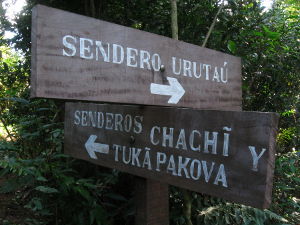 All in all the levels of touristic interest in San Rafael are rising. Both nationally and internationally there appears to be a heightened interest in the issues concerning the Atlantic Forest. Our nature trails and the museum there are always well visited.
Furthermore, participation at workshops and congresses abroad provided us with valuable new knowledge and experience, just as the cooperation with other environmental protection organisations and researchers also did.
Setting our hopes on a new government
The newly elected government seems to have placed the issue of a long-term solution for the San Rafael reserve higher up the agenda than the previous administration. There is talk of appointing three state wardens who would be stationed permanently in San Rafael. We obviously hope for a positive outcome as far as the negotiations are concerned, given that an increase in state support would enable us to work far more efficiently to combat illegal logging and hunting activities. A further piece of encouraging news was the fact that the moratorium aimed at protecting the forest has been extended by three years. During this period all parties have been asked to come up with a definitive solution. For our part we are receiving support from the WWF during these protracted discussions.
All in all the levels of touristic interest in San Rafael are rising. Both nationally and internationally there appears to be a heightened interest in the issues concerning the Atlantic Forest. Our nature trails and the museum there are always well visited.
Furthermore, participation at workshops and congresses abroad provided us with valuable new knowledge and experience, just as the cooperation with other environmental protection organisations and researchers also did.
Setting our hopes on a new government
The newly elected government seems to have placed the issue of a long-term solution for the San Rafael reserve higher up the agenda than the previous administration. There is talk of appointing three state wardens who would be stationed permanently in San Rafael. We obviously hope for a positive outcome as far as the negotiations are concerned, given that an increase in state support would enable us to work far more efficiently to combat illegal logging and hunting activities. A further piece of encouraging news was the fact that the moratorium aimed at protecting the forest has been extended by three years. During this period all parties have been asked to come up with a definitive solution. For our part we are receiving support from the WWF during these protracted discussions.
As you can see, dear friends and lovers of the Atlantic Forest, there have been many positive developments. Our work has been well worth it and it has to continue if we are to protect and save the remaining area of the Atlantic Forest. That's why we still need your help!